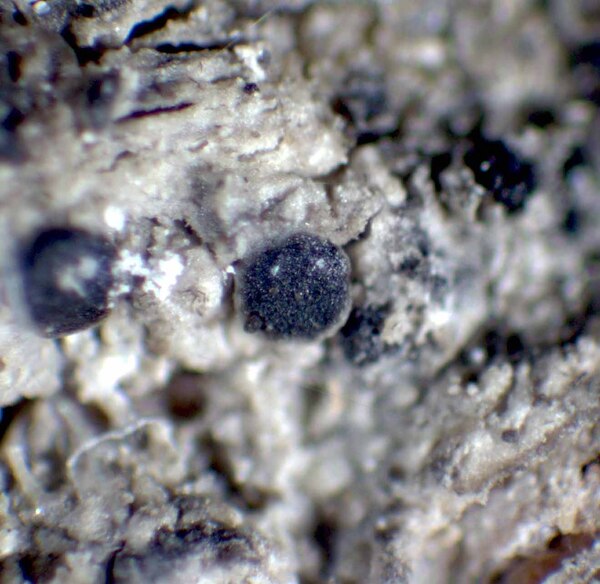Biatora mendax Anzi
Comm. Soc. Critt. Ital., 1, 3: 153, 1862.
Synonyms: Biatora propinquata (Nyl.) Arnold; Biatora subflavida (Nyl.) Arnold; Biatorina mendax (Anzi) Jatta; Catillaria mendax (Anzi) Lettau; Lecidea propinquata Nyl.; Lecidea subflavida Nyl.
Distribution: N - Frl (Tretiach & Carvalho 1995, Printzen 1995), TAA (Printzen 1995, Nascimbene & al. 2022), Lomb (Anzi Lich. Lang. 168: Printzen 1995, Ravera & al. 2023). S - Cal.
Description: Thallus crustose, thinly episubstratic, greenish grey to pale grey (turning beige to pale brown in the herbarium), continuous to rimose-areolate, the areoles (which are rarely well-developed) flat, 0.25-0.8 mm wide, with partially raised margins. Apothecia biatorine, rounded or slightly irregular in outline, sessile with a slightly constricted basis, 0.4-0.7(-1) mm across, with a brown-black to black, rarely grey-brown, epruinose, flat to moderately convex disc, and an often slightly paler, thin, finally excluded proper margin; damaged apothecia often become tuberculate. Proper exciple well-developed, of branched, radiating hyphae with protruding, capitate terminal cells; epithecium sordid brown, K-, N-; hymenium colourless or brownish, 35-60 µm high; paraphyses simple or sparingly branched in upper part, 1-1.5(-2) µm thick at mid-level, the apical cells slightly swollen; hypothecium colourless, pale sordid brown, N-, 30-80 µm high, hardly distinct from the subhymenium. Asci 8-spored, clavate, with a K/I+ blue apical dome penetrated by a narrow, K/I– apical cushion surrounded by a narrow, deeply K/I+ blue zone, the wall K/I- but surrounded by an I+ red-brown, K/I+ blue outer layer, the ocular chamber relatively small, Biatora-type, 38-51 x 9-12.5 µm. Ascospores 1-celled (rarely 1-septate), hyaline, oblong-fusiform, (9-)12-17(-20) x (3-)3.5-4.5(-5.5) µm. Pycnidia rare, immersed, colourless or dark brown in the periostiolar region, more or less globose, c. 140 µm across. Conidia 5.5-8 x 0.7-1 µm. Photobiont chlorococcoid. Spot tests: thallus K-, C-, KC-, P+ orange-red. Chemistry: thallus with argopsin and traces of norargopsin.
Note: an epiphytic species found in shaded and humid situations, with optimum in humid beech forests with Abies alba. It is included in the Italian red list of epiphytic lichens as “Endangered” (Nascimbene & al. 2013c).
Growth form: Crustose
Substrata: bark
Photobiont: green algae other than Trentepohlia
Reproductive strategy: mainly sexual
Commonnes-rarity: (info)
Alpine belt: absent
Subalpine belt: extremely rare
Oromediterranean belt: absent
Montane belt: very rare
Submediterranean belt: absent
Padanian area: absent
Humid submediterranean belt: absent
Humid mediterranean belt: absent
Dry mediterranean belt: absent

Predictive model
Herbarium samples
Growth form: Crustose
Substrata: bark
Photobiont: green algae other than Trentepohlia
Reproductive strategy: mainly sexual
Commonnes-rarity: (info)
Alpine belt: absent
Subalpine belt: extremely rare
Oromediterranean belt: absent
Montane belt: very rare
Submediterranean belt: absent
Padanian area: absent
Humid submediterranean belt: absent
Humid mediterranean belt: absent
Dry mediterranean belt: absent

Predictive model
| Herbarium samples |
 Index Fungorum
Index Fungorum
 GBIF
GBIF




